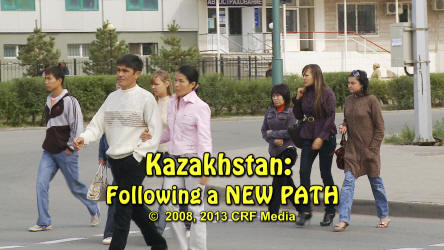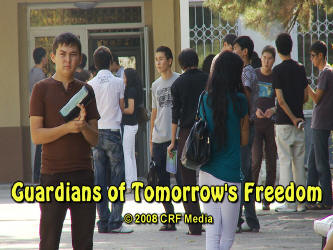 |
00-21 Kazakhstan 2008 29 Chapters (209:36) Script: Kazakhstan .pdf 03/25/2023
21 Kazakhstan
2008 (19:33)
No longer a vassal of the former Soviet Union, Kazakhstan is now free to
follow a new path. The people have opportunities
unknown to generations past.
We arrived in Astana, the gleaming new capital of this country, in early
September for a three-week visit. It was an ambitious agenda to tour most
of the large cities as well as several smaller towns and villages. To
accomplish this, we would be working with several different missionaries
that we had corresponded with by e-mail. Originally, Don and Dian Combs,
our friends from Belarus, were to be our primary hosts. They had been
reassigned to Kazakhstan and were looking forward to helping us with the
new DVD. Unfortunately, health problems confined them to the United
States. This meant we would be working with people we had never met. Yet,
we were trusting God to make our pathway clear.
It is a country endowed with abundant natural resources and a
multi ethnic people with a long history of cultural traditions and the
ability to survive in the harsh environment of the place they call home. It was also a place and a people where exploitation, slave labor,
mismanagement and oppression were all around. Yet, today they take pride
in an exuberant free market economy and a constitutional democracy.
This is a place with over 100
ethnic groups living side by side and going about their daily routines.
About 55% are Kazakhs, 30% Russians and the remainder include Germans,
Ukrainians, Uygars and Tatars.
The fall of the former
Soviet Union in 1991 allowed this country to follow its own pathway to the
future. However, persecution remains. At a small house church
we were told not to publish anything identifying the
believers or the meeting location. The chapter Worshiping Isa was not published on
the Kazakhstan DVD. |
 02 Kazakhstan: The Country Maps (2:08) This short chapter includes video calibration charts. Kazakhstan is located in central Asia and was once a part of the former Soviet Union. China is to the East and Russia to the North and the West. Kazakhstan has an area of approximately one million square miles, one half that of the continental United States but with a population of less than 16 million.
|
 03 KAZAKHSTAN: A New Path (10:12) It has only been 17 years since the Republic of Kazakhstan declared its independence. The fall of the former Soviet Union in 1991 allowed this country to follow its own pathway to the future … a route not dictated by the authoritarian Communist powers of Moscow. Much has changed in this country in the past few years and, more is to come. |
 04 Seeds for Fallow Soil (7:10) Sheep and goats are still common in the rural areas of Kazakhstan as a lone herdsman cares for animals that once represented the resources of an entire village. The solitary rider looks after cattle and horses in a similar manner as his herd browses on the feather grass growing in the eastern regions of the steppe. A century ago the lifestyle was much different. 90% of the population of Kazakhstan lived off of the land. |
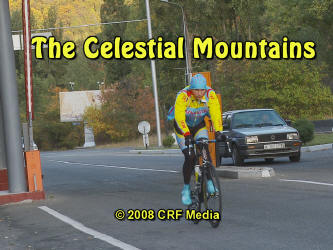 05 The Celestial Mountains (5:55) It is only about an hour’s drive south of Almaty to the Tien-Shan Mountains, "The Celestial Mountains”, a 1500-mile long mountain range that borders China to the East and Kyrgyzstan to the South. This is a place to get away from the crowded city, a place to rest, a place to enjoy, a place with memories of the past and promise of the future. The high peaks, the deep valleys and the cool crisp air are an invitation to all. |
 06 Wanderers-The Narrow Path, Pt 1 (3:41) History has brought together a multitude of peoples to form what is now known as Kazakhstan. Religious beliefs, political affiliations, lifestyle and physical appearance remain as guide posts for the pathways that individuals, families and ethnic groups follow. Originally this vast country was inhabited by nomadic tribes that traveled from place to place in small groups taking all of their possessions with them. |
 07 Pathway to Survival , Pt 2 (4:59) The legend associated with the Baiterek Tower in Astana symbolizes a mystic time when a dragon continually destroyed the hopes and dreams of the Kazakh people. But, 400 years ago there were many real dragons facing the nomads as they searched for the pathway to nationhood. This search turned out to be littered with destruction, disappointment and exploitation, when the future was in the hands of dragons. |
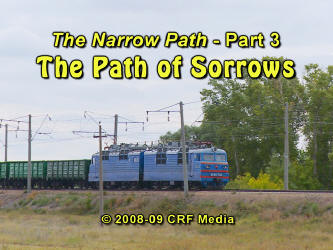 08 The Path of Sorrows, Pt 3 (11:30) Loads of coal, minerals and produce are common on these tracks that stretch across the Republic. This train is on its way to Astana and Karaganda in the central part of the country. In contrast, there were many trainloads of people following the same pathway during the reign of terror begun by Lenin and continued with vengeance by Stalin. Prison labor camps known as Gulags were set up to purge the Soviet Union of political decent. |
 09 Choosing a Path, Pt 4 (7:00) The citizens of Kazakhstan have much to sing about as they experience the benefits that freedom brings. In the 17 years since achieving independence, major changes have been made which have forever altered the culture of this country. The people, for the first time in their lives, have been given unprecedented freedom; freedom from the domination of the former Soviet Union.They now have many paths to choose from. |
 10 Going Forward with Pride (7:13) The nomadic lifestyle of the Kazakhs is no more. What once was a resilient and resourceful lifestyle, molded by the harsh environment of the steppe, became only a dream of the old way of life, which was eventually put in chains by forces outside the control of the people. Kazakhstan is a country that was devastated by many decades of powerful centralized control from Moscow. |
|
 12 A View From the Tenth Floor (10:56) It is a long way down to the street from Ivan’s tenth floor flat. At 8 o’clock in the morning there are only a few people up and about. For most, their work does not start until 9 o’clock. Of course, the construction cranes are silent now and they will probably not work today. Construction has slowed to almost a standstill due to financial problems and mismanagement. Ivan’s has three rooms with a total area of about 500 square feet. |
 13 On a Clear Day in Temirtau (4:13) On a clear day, smoke stacks can be seen pumping soot, ash, sulfur and other chemicals into the blue sky above the city known as “Iron Mountain” or, in the Kazakh language, “Temirtau”. It is iron that defines this city, its people and its purpose. The first iron smelter was put into operation in 1944. The following year the town name was changed from Samarkand to its current name and granted city status. |
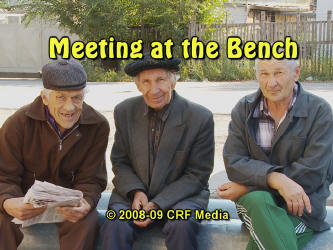 14 Meeting at the Bench (4:00) The favorite meeting place for these three gentlemen is under a shade tree with the large heating pipes for their bench. Their grandchildren are nearby … all enjoying the sunny afternoon. This is also a good place for the grandmothers to sit for awhile and share time with the young children as their parents are at work in the smoke shrouded metallurgical factories of Temirtau. |
 15 Karaganda: Overcoming Tragic Past (7:16) Karaganda of today is much like other large cities in Kazakhstan. The new imported cars making their way along the main street, as well as the large mural on the old apartment building, point to the present as well as to the future; except, the tragic past of this city is hidden from view, a time that shaped it’s destiny. |
 16 Saran: Changing Lives (6:36) The 30-mile drive from Karaganda to the small city of Saran is a vista of discouragement and lost dreams. All along the way, surrounded by the scrub vegetation of the steppe, are old decaying mines that once supplied coal to fuel the manufacturing and power generation for the Karaganda Oblast. The low efficiency and poor quality coal of these Soviet era facilities proved to be unsustainable in the free market economy. |
|
 18 Pravda Avenue (5:33) This street in Almaty, Kazakhstan once had the name of “Pravda”. The old street sign remains but the letters have long since faded. “Pravda” in the Russian language means “truth”. Pravda Avenue was so named during the time the former Soviet Union controlled this land and Almaty was the capital of the Kazakh Soviet Socialist Republic. During those times, the traffic was much different. There were fewer automobiles and still fewer foreign imports.
|
 19 Bazaars: A Crossroads (6:22) The bazaar has long been the tradition of the peoples of Kazakhstan; often crowded, noisy and smelly but still it endures. It has grown dramatically since independence; since a true market economy came into being. The old days of Soviet “Pravda”, of their form of truth, are gone. The days of bare shelves are no more. There were few choices then but now the bazaar is all about choices, competition, barter, and full shelves. |
|
|
These students at a major university in Almaty grew up in a free Kazakhstan. It was their parents and their grandparents who endured the repressive control of Moscow. They will soon be given the responsibility to protect as well as expand the hard won freedom they enjoy. Will they be up to the unknown challenges of tomorrow? The high schools are preparing the students to be responsible and informed. |
|
|
|
|
|
|
|
|
|
|
|
|
|
Statement About Video Use U.S. copyright laws protect all media material produced by CRF Media. Posting the videos on alternate web sites is NOT ALLOWED. Fragmentation of the material is STRICTLY FORBIDDEN. THEY ARE NOT TO BE USED IN ANY WAY FOR COMMERCIAL APPLICATIONS. |
|
|
|
|
